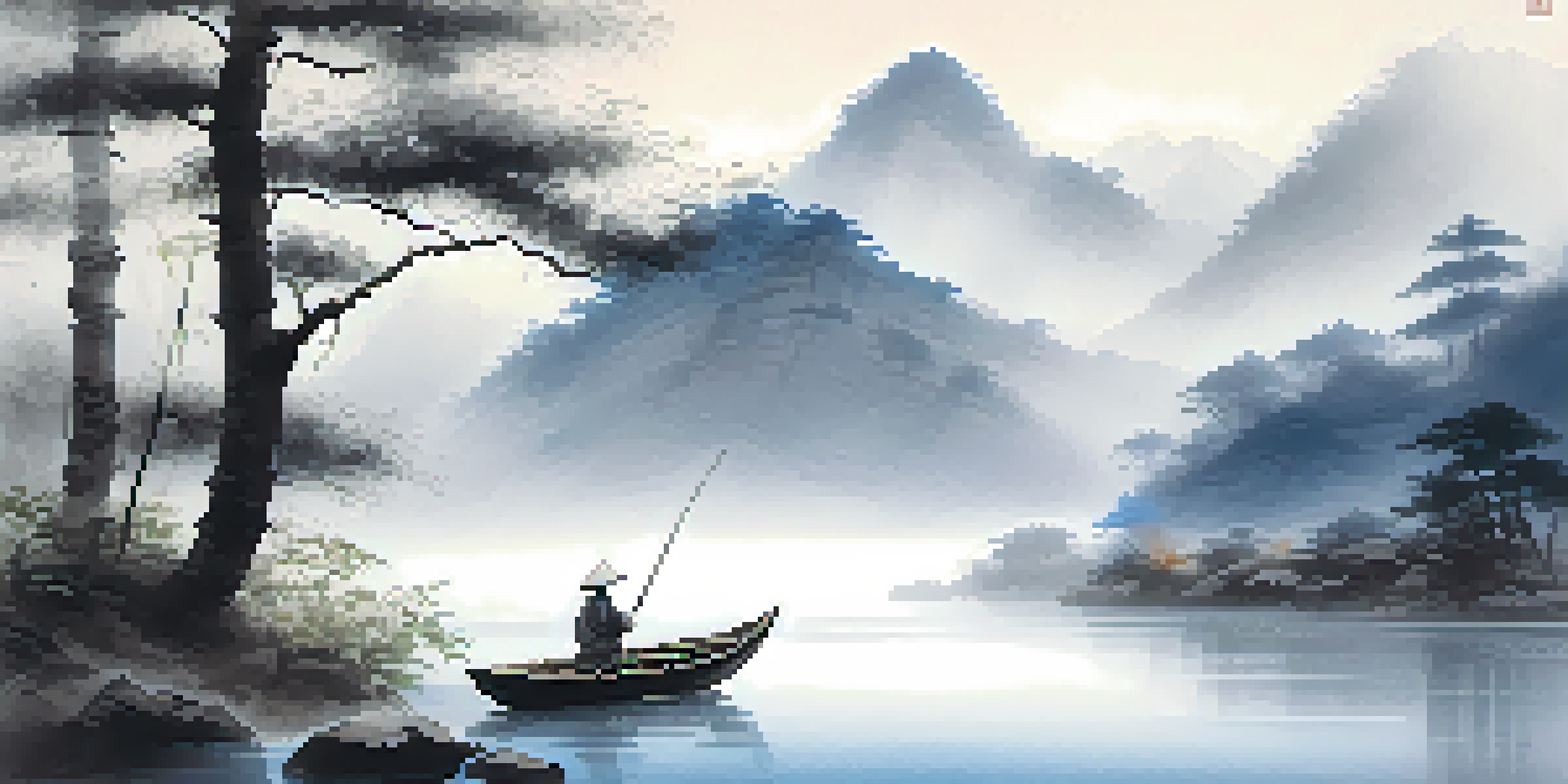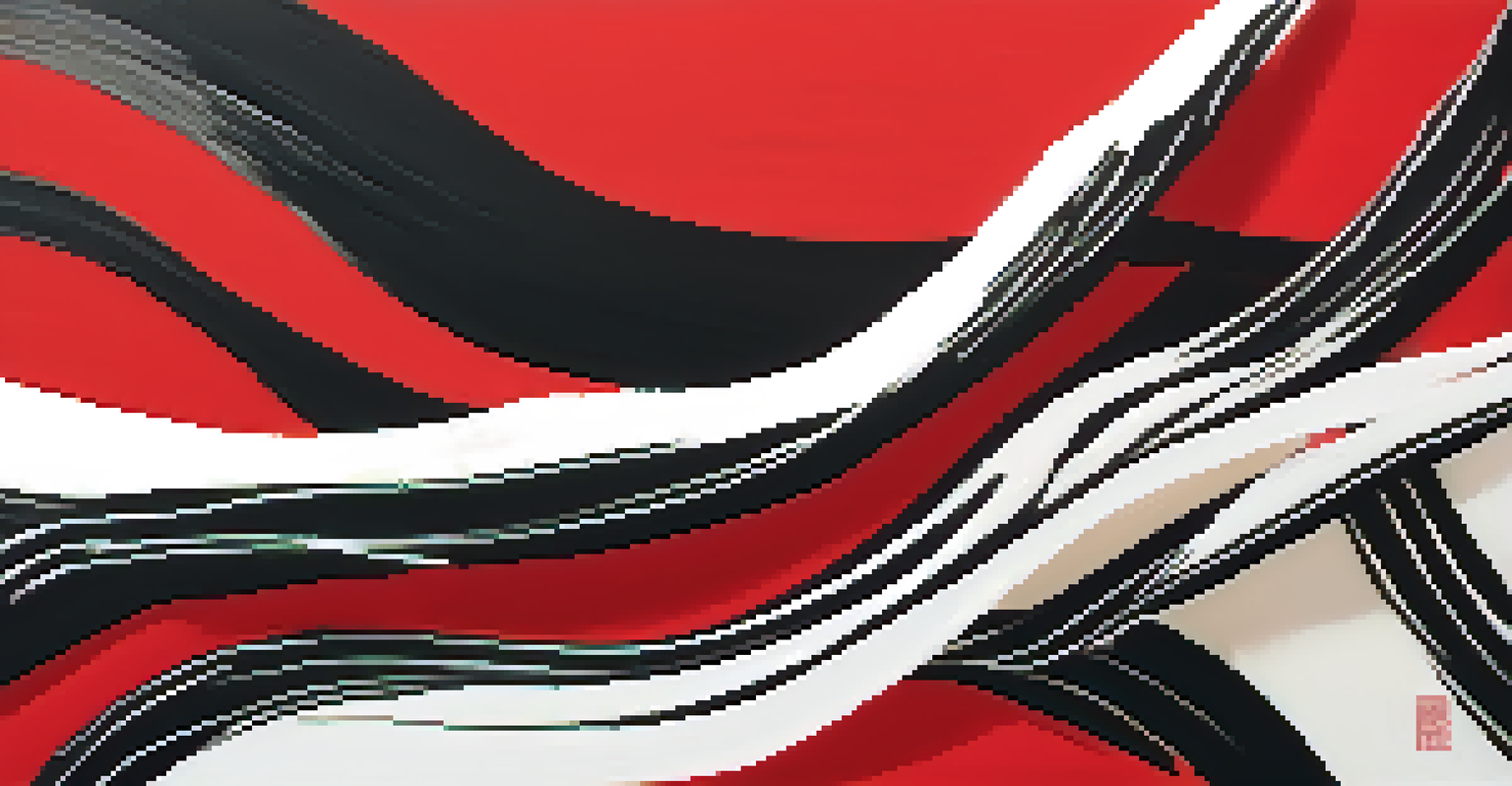Exploring Eastern Artistic Techniques in Western Painting

Introduction to Eastern Artistic Techniques
Eastern artistic techniques encompass a variety of styles and philosophies that have flourished in countries like China, Japan, and India. These methods emphasize harmony, nature, and spirituality, often using unique materials and tools. Understanding these techniques can provide a fresh perspective for Western artists looking to innovate.
Art is the most beautiful of all lies.
For instance, traditional Chinese ink wash painting, known as 'shui-mo,' focuses on capturing the essence of a subject rather than its exact likeness. This approach can inspire Western painters to explore abstraction and interpretation in their own work. By blending these diverse artistic practices, artists can create something truly unique.
Moreover, the principles of Eastern art, such as balance and simplicity, can guide Western artists in refining their techniques. As the art world becomes increasingly globalized, the fusion of these cultures presents exciting opportunities for creativity and expression.
The Influence of Calligraphy on Western Styles
Calligraphy, particularly from East Asia, has a profound influence on Western art, especially in its emphasis on fluidity and form. The strokes in calligraphy are deliberate and expressive, and artists can learn to apply these principles to their painting techniques. This connection between text and imagery can create a richer visual narrative.

For example, the flowing lines of Arabic calligraphy have inspired artists like Cy Twombly, who incorporated similar gestures into his abstract works. By exploring the dynamics of calligraphy, Western artists can enhance their understanding of line and movement, leading to more expressive pieces.
Eastern Techniques Inspire Western Art
Eastern artistic methods, emphasizing harmony and balance, offer fresh perspectives for Western artists seeking innovation.
Additionally, the meditative practice of calligraphy encourages artists to slow down and focus on the act of creation, fostering a deeper connection to their work. This mindful approach can transform the artistic process, allowing for greater emotional depth and intentionality.
Color Theory: Eastern Perspectives in Western Art
Color theory in Eastern art often differs significantly from Western perspectives, focusing on the emotional and symbolic meanings behind colors. For instance, red symbolizes good fortune and joy in Chinese culture, while in Western art, it can represent passion or danger. By blending these interpretations, artists can add layers of meaning to their work.
Art is not what you see, but what you make others see.
Western painters like Mark Rothko have drawn inspiration from Eastern color palettes, utilizing color to evoke specific emotions. Rothko’s large fields of color provoke introspection, a technique that aligns with the emotional resonance found in Eastern art. This cross-pollination can lead to innovative uses of color in contemporary art.
Furthermore, understanding how different cultures perceive color can enhance an artist's ability to communicate with their audience. By incorporating Eastern views on color, Western artists can create pieces that resonate on a deeper, more universal level.
Composition: Eastern Balance in Western Painting
Eastern art often emphasizes balance and asymmetry in composition, which contrasts with the more rigid structures frequently found in Western painting. This approach encourages artists to think outside the box and explore unconventional arrangements in their work. Learning to balance elements without symmetry can lead to dynamic compositions.
Japanese ink paintings, for example, utilize negative space effectively, allowing the viewer's eye to move freely across the canvas. This technique can inspire Western artists to reconsider their own use of space and how it contributes to the overall impact of a piece. A thoughtful composition can draw viewers in and create a more engaging experience.
Symbolism Bridges Cultural Gaps
Incorporating Eastern symbols into Western art enriches storytelling and invites deeper viewer engagement.
Additionally, the concept of 'ma,' or negative space in Japanese aesthetics, highlights the importance of what is not present. By embracing this idea, Western artists can cultivate a sense of openness and contemplation in their artwork, inviting viewers to reflect more deeply.
Textural Techniques from Eastern Art
Texture plays a vital role in both Eastern and Western art, but the methods of achieving it can vary greatly. Eastern artists often use natural materials such as rice paper and ink, which yield unique textural qualities. Western artists can adopt these materials and techniques to enrich their own work and create varied surface effects.
For example, the use of layering in traditional Japanese woodblock printing creates intricate textures that add depth to the final image. Western artists can experiment with similar layering techniques using contemporary mediums, allowing for innovative approaches to texture in their paintings. This fusion can lead to an exciting exploration of materials.
Moreover, the tactile nature of Eastern art encourages a hands-on approach to creation, reminding artists of the physicality of their craft. By embracing this textural focus, Western artists can cultivate a more sensory experience for themselves and their audience.
Symbolism in Eastern Art and Its Western Adaptation
Symbolism is a crucial aspect of Eastern art, where every element often carries significant meaning. For instance, lotus flowers represent purity and enlightenment in many Eastern cultures. By integrating such symbols into their work, Western artists can add layers of interpretation and invite viewers to engage more deeply with their pieces.
Artists like Georgia O'Keeffe have incorporated Eastern symbols into their Western styles, using elements like flowers to evoke specific emotions and ideas. This blending of symbolism allows for a richer dialogue between cultures and can lead to innovative storytelling in art. It encourages artists to think critically about the messages they wish to convey.
Fusion Creates New Artistic Horizons
The collaboration between Eastern and Western techniques fosters a more inclusive and dynamic art community.
Furthermore, understanding the cultural significance of various symbols can enhance an artist's ability to communicate complex themes. By thoughtfully incorporating Eastern symbolism, Western artists can create works that resonate on multiple levels, bridging cultural gaps and sparking conversation.
Conclusion: The Future of Art Through Cultural Fusion
The exploration of Eastern artistic techniques in Western painting opens up a world of possibilities for artists. As the art community becomes more interconnected, the fusion of these diverse traditions allows for innovative expressions that transcend cultural boundaries. This collaboration not only enriches the artists but also enhances the viewer's experience.
By embracing Eastern methods, Western artists can push the limits of their creativity, challenging conventional norms and exploring fresh perspectives. This dialogue between cultures can lead to a more inclusive art world, where diverse voices and ideas thrive. The future of art lies in this beautiful fusion.

In conclusion, as artists continue to explore the intersections of Eastern and Western techniques, they create a dynamic landscape that celebrates creativity, innovation, and cultural exchange. The journey into these artistic realms not only broadens their own horizons but also invites us all to appreciate the rich tapestry of global art.